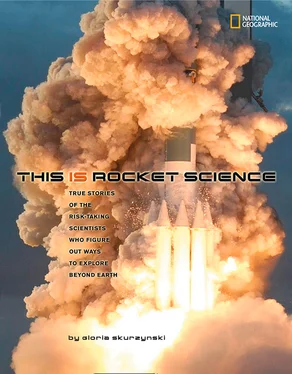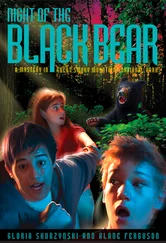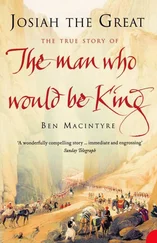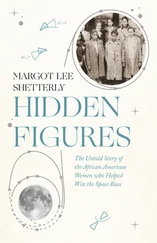THIS IS ROCKET SCIENCE
TRUE STORIES OF THE RISK-TAKING SCIENTISTS WHO FIGURE OUT WAYS TO EXPLORE BEYOND EARTH
FOR MEGAN ALANE GLORIA LEDESMA, WHO WILL LIVE IN A WHOLE NEW WORLD—GS
PUBLISHED BY THE NATIONAL GEOGRAPHIC SOCIETY
John M. Fahey, Jr.,
President & Chief Executive Officer
Gilbert M. Grosvenor,
Chairman of the Board
Tim T. Kelly,
President, Global Media Group
John Q. Griffin,
Executive Vice President; President, Publishing
Nina D. Hoffman,
Executive Vice President; President, Book Publishing Group
Melina Gerosa Bellows,
Executive Vice President, Children’s Publishing
PREPARED BY THE BOOK DIVISION
Nancy Laties Feresten,
Vice President, Editor in Chief, Children’s Books
Jonathan Halling,
Design Director, Children’s Publishing
Jennifer Emmett,
Executive Editor, Reference & Solo Titles, Children’s Books
Carl Mehler,
Director of Maps
R. Gary Colbert,
Production Director
Jennifer A. Thornton,
Managing Editor
STAFF FOR THIS BOOK
Suzanne Fonda,
Project Editor
David M. Seager,
Art Director
Lori Epstein, Gloria Skurzynski,
Illustrations Editors
Priyanka Lamichhane,
Associate Editor
Grace Hill,
Associate Managing Editor
Lewis R. Bassford,
Production Manager
Susan Borke,
Legal and Business Affairs
Manufacturing and Quality Management
Christopher A. Liedel,
Chief Financial Officer
Phillip L. Schlosser,
Vice President
Chris Brown,
Technical Director
Nicole Elliott, Rachel Faulise,
Managers
ACKNOWLEDGMENTS
The author is exceedingly grateful to rocket scientist Ed Skurzynski and to dedicated editor Suzanne Patrick Fonda and art director David Seager for their continuous support. Deep thanks also to Françoise Ulam; to David S. Nolan; Marc Rayman at NASA Jet Propulsion Laboratory; Mike Wright and Betty Humphery at NASA Marshall Space Flight Center; Norman Chaffee, Roger Weiss, and Mike Gentry at NASA Johnson Space Center; Gwen Pitman at NASA Media Services; Linda S. Sandoval at Los Alamos National Laboratory; Suzanne DuBeau Rostek at Astrotech Space Operations, Inc; Valerie-Anne Lutz van Ammers at the American Philosophical Society Library; Andrew Ilin at Ad Astra; Roger G. Gilbertson at SpaceX; Jordin Kare at Laser-Motive; and, for her continuing inspiration to students, to France Anne Cordova, President of Purdue University and former NASA Chief Scientist, the youngest person and first woman to hold that position.
The National Geographic Society is one of the world’s largest nonprofit scientific and educational organizations. Founded in 1888 to “increase and diffuse geographic knowledge,” the Society works to inspire people to care about the planet. It reaches more than 325 million people worldwide each month through its official journal, National Geographic, and other magazines; National Geographic Channel; television documentaries; music; radio; films; books; DVDs; maps; exhibitions; school publishing programs; interactive media; and merchandise. National Geographic has funded more than 9,000 scientific research, conservation and exploration projects and supports an education program combating geographic illiteracy. For more information, visit nationalgeographic.com.
For more information, please call 1-800-NGS LINE (647-5463) or write to the following address:
National Geographic Society
1145 17th Street N.W.
Washington, D.C. 20036-4688 U.S.A.
Visit us online at www.nationalgeographic.com/books
For librarians and teachers: www.ngchildrensbooks.org
More for kids from National Geographic: kids.nationalgeographic.com
For rights or permissions inquiries, please contact National Geographic Books Subsidiary Rights: ngbookrights@ngs.org
Copyright © 2010 Gloria Skurzynski. All rights reserved. Reproduction of the whole or any part of the contents without written permission from the publisher is prohibited.
Skurzynski, Gloria.
This is rocket science: true stories of the risk-taking scientists who figure out ways to explore beyond Earth / by Gloria Skurzynski.
p. cm.
Includes bibliographical references and index.
ISBN: 978-1-4263-0717-1
1. Rocketry—Biography. 2. Aerospace engineers—Biography—Juvenile literature. 3. Rocketry—History—Juvenile literature. 4. Rockets (Aeronautics)—History—Juvenile literature. I. Title.
TL781.85.A1S58 2010
629.4092’2—dc22
2009020386
Version: 2017-07-05
FIRE ARROWS
THE FATHERS OF MODERN ROCKETRY
BEEPS FROM SPACE
SATURN WINS, ORION LOSES
RETURN AND REUSE
SUCCESS AND FAILURE
WAY TO GO
FARTHER NEEDS FASTER
GLOSSARY
BOOKS AND WEB SITES
QUOTE SOURCES AND ILLUSTRATION CREDITS
INDEX
IN THE 13TH CENTURY THE CHINESE DESIGNED FIRE ARROWS TO USE AS WEAPONS AGAINST INVADING MONGOL ARMIES.
Some inventions happen by accident. Two thousand years ago, Chinese scientists searched for a way to make people immortal. They mixed chemicals with liquids and drank them, hoping this would keep them alive forever. Instead, they often died quickly because their experiments contained poisons.
One of the main ingredients in those potions was saltpeter, a potassium nitrate compound found in dry caves in southern China. Alchemists (the scientists searching for eternal life) used saltpeter to dissolve ores and minerals. They learned how to make pure sulfur by heating iron pyrite, also known as fool’s gold. And they could easily obtain carbon from coal or charcoal. During centuries of experimentation, the alchemists discovered that if saltpeter, sulfur, and carbon were combined, the mixture would burn.
By A.D. 1040 a Chinese official described three combinations of these ingredients to make three different kinds of weapons: a poison-smoke ball, a bomb that burned, and a bomb that exploded—but not violently. Later experiments showed that when extra saltpeter was added to the three main ingredients, the combination exploded with greater force. This became the earliest form of gunpowder, named huo yao, meaning “flaming medicine.”
Hollow bamboo tubes filled with this early kind of gunpowder exploded spectacularly when thrown into a fire.
These were the first fireworks. Chinese experimenters attached arrows to these tubes, sealed the tubes at one end, and left the tubes open at the other end. When the gunpowder was lit, a mixture of fire, smoke, and gas flew out through the open end and propelled the weapon forward. Called fire arrows, these weapons weren’t accurate enough to hit their targets very often, but their loud explosions frightened enemies. Chinese crossbowmen could shoot the arrows as far as 650 feet.
AT FIRST, FIRE ARROWS FRIGHTENED MONGOL INVADERS AND TERRIFIED THEIR HORSES. THEN THE SOLDIERS LEARNED TO USE FIRE ARROWS AGAINST THEIR OWN ENEMIES.
To the north of China lived nomadic tribes that moved their herds over vast distances of unbroken deserts and grasslands. Many of these tribes united to form the Mongol Empire under the command of the famous Genghis Khan. In A.D. 1232 an army of 30,000 Mongol warriors invaded the Chinese city of Kai-fung-fu, where the Chinese fought back with fire arrows. A book about this battle describes the destruction caused by a single fire arrow: “When it was lit, it made a noise that resembled thunder and extended [about 15 miles]. The place where it fell was burned, and the fire reached more than 2000 feet…. These iron nozzles, the flying powder halberds that were hurled, were what the Mongols feared most.” The explosions especially terrified the horses. Mongol leaders learned from their enemies and found ways to make fire arrows even more deadly as their invasion spread toward Europe.
Читать дальше












